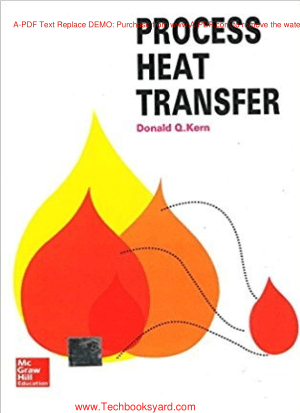PREFACE TO THE THIRD EDITION
Professor Obert has observed in his famous treatise on Thermodynamics that concepts are
better understood by their repeated applications to real life situations. A firm conviction of
this principle has prompted the author to arrange the text material in each chapter in the
following order.
In the first section after enunciating the basic concepts and laws mathematical models
are developed leading to rate equations for heat transfer and determination of temperature
field, simple and direct numerical examples are included to illustrate the basic laws. More
stress is on the model development as compared to numerical problems.
Optimisation of the shape of the fin of specified volume for maximum
heat flow is discussed. Circumferential fins and variable area fins are analysed. The use of
numerical method is illustrated. Error in measurement of temperature using thermometer is
well discussed. The possibility of measurement of thermal conductivity and convective heat
transfer coefficient using fins is illustrated.
Two dimensional steady state conduction is discussed in the fifth chapter. Exact analysis
is first developed for two types of boundary conditions. The use of numerical method is illustrated
by developing nodal equations. The concept and use of conduction shape factor is illustrated
for some practical situations.
One dimensional transient (unsteady) heat conduction is discussed in Chapter 6. Three
types of models arise in this case namely lumped heat capacity system, semi-infinite solid and
infinite solid. Lumped heat capacity model for which there are a number of industrial
applications is analysed in great detail and problems of practical interest are shown solved.
The condition under which semi-infinite solid model is applicable as compared to infinite solid
model is clearly explained. Three types of boundary conditions are analysed. Infinite solid
model for three geometric shapes is analysed next. The complexity of the analytical solution is
indicated. Solution using charts is illustrated in great detail. Real solids are of limited
dimensions and these models cannot be applied directly in these cases. In these cases product
solution is applicable. A number of problems of practical interest for these types of solids are
worked out in this section. In both cases a number of problems are solved using numerical
methods. Periodic heat flow problems are also discussed.
Concepts and mechanism of convection are discussed in the seventh chapter. After
discussing the boundary layer theory continuity, momentum and energy equations are derived.
Next the different methods of solving these equations are discussed. In addition to the exact
analysis approximate integral method, analogy method and dimensional analysis are also
discussed and their applicability is indicated. General correlations for convective heat transfer
coefficient in terms of dimensionless numbers are arrived at in this chapter.
In Chapter 8, in addition to the correlations derived in the previous chapter, empirical
correlations arrived at from experimental results are listed and applied to flow over surfaces
like flat plate, cylinder, sphere and banks of tubes. Both laminar and turbulent flows situation
are discussed.
Flow through ducts is discussed in Chapter 9. Empirical correlations for various situations
are listed. Flow developing region, fully developed flow conditions, constant wall temperature
and constant wall heat flux are some of the conditions analysed. Flow through non-circular
pipes and annular flow are also discussed in this chapter.
Natural convection is dealt with in Chapter 10. Various geometries including enclosed
space are discussed. The choice of the appropriate correlation is illustrated through a number
of problems. Combined natural and forced convection is also discussed.
Chapter 11 deals with phase change processes. Boiling, condensation, freezing and
melting are discussed. Basic equations are derived in the case of freezing and melting and
condensation. The applicable correlations in boiling are listed and their applicability is
illustrated through numerical examples.
Chapter 12 deals with heat exchangers, both recuperative and regenerative types. The
LMTD and NTU-effectiveness methods are discussed in detail and the applicability of these
methods is illustrated. Various types of heat exchangers are compared for optimising the size.
Thermal radiation is dealt with in Chapter 13. The convenience of the use of electrical
analogy for heat exchange among radiating surfaces is discussed in detail and is applied in
almost all the solved problems. Gas radiation and multi-body enclosures are also discussed.
Chapter 14 deals with basic ideas of mass transfer in both diffusion and convection
modes. A large number of problems with different fluid combinations are worked out in this
chapter.
CONTENTS
Preface to the Third Edition v
1 AN OVERVIEW OF HEAT TRANSFER 1–25
1.0 Introduction 1
1.1 Heat Transfer 1
1.2 Modes of Heat Transfer 2
1.3 Combined Modes of Heat Transfer 8
1.4 Dimensions and Units 10
1.5 Closure 11
Solved Problems 11
Exercise Problems 22
2 STEADY STATE CONDUCTION 26–98
2.0 Conduction 26
2.1 The General Model for Conduction Study 26
2.2 Steady Conduction in One Direction (One Dimensional) 30
2.3 Conduction in Other Shapes 41
2.4 One Dimensional Steady State Heat Conduction with Variable Heat
Conductivity or Variable Area Along the Section 42
2.5 Critical Thickness of Insulation 48
2.6 Mean Area Concept 50
2.7 Parallel Flow 51
Solved Problems 53
Objective Questions 92
Exercise Problems 93
3 CONDUCTION WITH HEAT GENERATION 99–127
3.0 Introduction 99
3.1 Steady State One Dimensional Conduction in a Slab with Uniform Heat
Generation 99
3.2 Steady State Radial Heat Conduction in Cylinder with Uniform Heat Generation 103
3.3 Radial Conduction in Sphere with Uniform Heat Generation 107
3.4 Conclusion 109
Solved Problems 110
Objective Questions 125
Exercise Problems 125
4 HEAT TRANSFER WITH EXTENDED SURFACES (FINS) 128–175
4.0 Introduction 128
4.1 Fin Model 129
4.2 Temperature Calculation 130
4.3 Heat Flow Calculation 134
4.4 Fin Performance 139
4.5 Circumferential Fins and Plate Fins of Varying Sections 142
4.6 Optimisation 145
4.7 Fin with Radiation Surroundings 146
4.8 Contact Resistance 146
4.9 Numerical Method 147
Solved Problems 148
Objective Questions 170
Exercise Problems 172
5 TWO DIMENSIONAL STEADY HEAT CONDUCTION 176–201
5.0 Introduction 176
5.1 Solution to Differential Equation 176
5.2 Graphical Method 182
5.3 Numerical Method 184
5.4 Electrical Analogy 187
5.5 In the Finite Difference Formulation 187
Solved Problems 188
Exercise Problems 199
6 TRANSIENT HEAT CONDUCTION 202–284
6.0 Introduction 202
6.1 A Wall Exposed to the Sun 202
6.2 Lumped Parameter Model 203
6.3 Semi Infinite Solid 207
6.4 Periodic Heat Conduction 213
6.5 Transient Heat Conduction in Large Slab of Limited Thickness, Long Cylinders
and Spheres 215
6.6. Product Solution 227
6.7 Numerical Method 230
6.8 Graphical Method 233
Solved Problems 234
Objective Questions 278
Exercise Problems 280
7 CONVECTION 285–333
7.0 Introduction 285
7.1 Mechanism of Convection 285
7.2 The Concept of Velocity Boundary Layer 287
7.3 Thermal Boundary Layer 289
7.4 Laminar and Turbulent Flow 291
7.5 Forced and Free Convection 292
7.6 Methods Used in Convection Studies 293
7.7 Energy Equation 299
7.8 Integral Method 302
7.9 Dimensional Analysis 303
7.10 Analogical Methods 306
7.11 Correlation of Experimental Results 307
Solved Problems 308
Objective Questions 331
Exercise Problems 332
8 CONVECTIVE HEAT TRANSFER—PRACTICAL CORRELATIONS
—FLOW OVER SURFACES 334–384
8.0 Introduction 334
8.1 Flow Over Flat Plates 334
8.2 Turbulent Flow 343
8.3 Flow Across Cylinders 348
8.4 Flow Across Spheres 356
8.5 Flow Over Bluff Bodies 359
8.6 Flow Across Bank of Tubes 360
Solved Problems 363
Objective Questions 380
Exercise Problems 381
9 FORCED CONVECTION 385–433
9.0 Internal Flow 385
9.1 Hydrodynamic Boundary Layer Development 386
9.2 Thermal Boundary Layer 387
9.3 Laminar Flow 388
9.4 Turbulent Flow 399
9.5 Liquid Metal Flow 402
9.6 Flow Through Non-circular Sections 404
9.7 The Variation of Temperature Along the Flow Direction 406
Solved Problems 408
Objective Questions 431
Exercise Problems 432
10 NATURAL CONVECTION 434–479
10.0 Introduction 434
10.1 Basic Nature of Flow Under Natural Convection Conditions 435
10.2 Methods of Analysis 437
10.3 Integral Method 439
10.4 Correlations from Experimental Results 442
10.5 A More Recent Set of Correlations 446
10.6 Constant Heat Flux Condition—Vertical Surfaces 447
10.7 Free Convection from Inclined Surfaces 451
10.8 Horizontal Cylinders 454
10.9 Other Geometries 455
10.10 Simplified Expressions for Air 456
10.11 Free Convection in Enclosed Spaces 458
10.12 Rotating Cylinders, Disks and Spheres 459
10.13 Combined Forced and Free Convection 460
Solved Problems 461
Objective Questions 477
Exercise Problems 477
11 PHASE CHANGE PROCESSES—BOILING, CONDENSATION
FREEZING AND MELTING 480–520
11.0 Introduction 480
11.1 Boiling or Evaporation 480
11.2 The correlations 483
11.3 Flow Boiling 485
11.4 Condensation 488
11.5 Freezing and Melting 494
Solved Problems 494
Objective Questions 516
Exercise Problems 518
12 HEAT EXCHANGERS 521–577
12.0 Introduction 521
12.1 Over All Heat Transfer Coefficient 521
12.2 Classification of Heat Exchangers 524
12.3 Mean Temperature Difference—Log Mean Temperature Difference 526
12.4 Regenerative Type 531
12.5 Determination of Area in Other Arrangements 531
12.6 Heat Exchanger Performance 535
12.7 Storage Type Heat Exchangers 547
12.8 Compact Heat Exchangers 550
Solved Problems 550
Objective Questions 572
Exercise Problems 574
13 THERMAL RADIATION 578–655
13.0 Introduction 578
13.1 Black Body 579
13.2 Intensity of Radiation 583
13.3 Real Surfaces 584
13.4 Radiation Properties of Gases—Absorbing, Transmitting and Emitting Medium 587
13.5 Heat Exchange by Radiation 595
13.6 Radiant Heat Exchange Between Black Surfaces 604
13.7 Heat Exchange by Radiation Between Gray Surfaces 606
13.8 Effect of Radiation on Measurement of Temperature by a Bare Thermometer 613
13.9 Multisurface Enclosure 614
13.10 Surfaces Separated by an Absorbing and Transmitting Medium 617
Solved Problems 618
Objective Questions 648
Exercise Problems 650
14 MASS TRANSFER 656–701
14.0 Introduction 656
14.1 Properties of Mixture 656
14.2 Diffusion Mass Transfer 657
14.3 Fick’s Law of Diffusion 657
14.4 Equimolal Counter Diffusion 659
14.5 Stationary Media with Specified Surface Concentration 660
14.6 Diffusion of One Component into a Stationary Component or
Unidirectional Diffusion 661
14.7 Unsteady Diffusion 661
14.8 Convective Mass Transfer 662
14.9 Similarity Between Heat and Mass Transfer 664
Solved Problems 664
Exercise Problems 680
Fill in the Blanks 682
State True or False 699
Short Questions 702
Appendix 707
References 712






